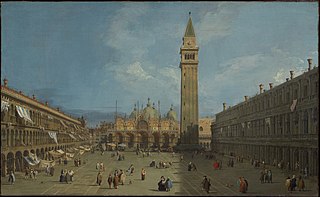
Piazza San Marco, often known in English as St Mark's Square, is the principal public square of Venice, Italy, where it is generally known just as la Piazza. All other urban spaces in the city are called campi ("fields"). The Piazzetta is an extension of the Piazza towards San Marco basin in its south east corner. The two spaces together form the social, religious and political centre of Venice and are commonly considered together. This article relates to both of them.

The architecture of cathedrals and great churches is characterised by the buildings' large scale and follows one of several branching traditions of form, function and style that derive ultimately from the Early Christian architectural traditions established in Late Antiquity during the Christianization of the Roman Empire.

Burano is an island in the Venetian Lagoon, northern Italy, near Torcello at the northern end of the lagoon, known for its lace work and brightly coloured homes. The primary economy is tourism.

The Collegiata di Santa Maria Assunta or Duomo di San Gimignano is a Roman Catholic collegiate church and minor basilica in San Gimignano, in Tuscany in central Italy. It contains important cycles of Renaissance frescoes by artists including Domenico Ghirlandaio, Benozzo Gozzoli, Taddeo di Bartolo, Lippo Memmi and Bartolo di Fredi. It falls within the UNESCO World Heritage Site of the "Historic Centre of San Gimignano", with its frescoes being described by UNESCO as "works of outstanding beauty".

Asciano is a comune and hill town in the province of Siena in the Italian region Tuscany. It is located at the centre of the Crete senesi between the river Ombrone and the torrent Copra, some 30 kilometres (19 mi) southeast of the town of Siena by rail.

San Martino ai Monti, officially known as Santi Silvestro e Martino ai Monti, is a minor basilica in Rome, Italy, in the Rione Monti neighbourhood. It is located near the edge of the Parco del Colle Oppio, near the corner of Via Equizia and Viale del Monte Oppio, about five to six blocks south of Santa Maria Maggiore.

Poggibonsi is a town in the province of Siena, Tuscany, central Italy. It is located on the river Elsa and is the main centre of the Valdelsa Valley.

Alzano Lombardo is a comune in the province of Bergamo, Lombardy, northern Italy.

Nembro is a comune (municipality) in the Province of Bergamo in the Italian region of Lombardy, located about 60 kilometres (37 mi) northeast of Milan and about 10 kilometres (6 mi) northeast of Bergamo, on the right bank of the Serio River.

Zogno is a comune (municipality) in the Province of Bergamo in the Italian region of Lombardy, located about 50 kilometres (31 mi) northeast of Milan and about 11 kilometres (7 mi) north of Bergamo.
San Martino may refer to:

Andrea Fantoni (1659–1734) was an Italian sculptor and woodcarver of the late-Baroque period, active in the region near Bergamo.

Padua Cathedral, or Basilica Cathedral of Saint Mary of the Assumption, is a Catholic church and minor basilica located on the east end of Piazza Duomo, adjacent to the bishop's palace in Padua, Veneto, Italy.

The Basilica of San Michele Maggiore is a church of Pavia, one of the most striking example of Lombard-Romanesque style. It dates from the 11th and 12th centuries.

The Basilica di San Pietro di Castello, commonly called San Pietro di Castello, is a Roman Catholic minor basilica of the Patriarch of Venice located in the Castello sestiere of the Italian city of Venice. The present building dates from the 16th century, but a church has stood on the site since at least the 7th century. From 1451 to 1807, it was the city's cathedral church, though hardly playing the usual dominant role of a cathedral, as it was overshadowed by the "state church" of San Marco, and inconveniently located. During its history the church has undergone a number of alterations and additions by some of Venice's most prominent architects. Andrea Palladio received his first commission in the city of Venice from the Patriarch Vincenzo Diedo to re-build the facade and interior of St Pietro, but Diedo's death delayed the project.
Giovan Battista Dell'Era was an Italian painter.

Belluno Cathedral is a Roman Catholic cathedral in the historic centre of the city of Belluno, Veneto, Italy, dedicated to Saint Martin. It is the episcopal seat of the diocese of Belluno-Feltre. It was elevated to the status of a minor basilica on 18 June 1980 by Pope John Paul II.

Larino Cathedral is a Roman Catholic cathedral located in Larino in the Province of Campobasso, Molise, Italy. The dedication is to the Assumption of the Virgin Mary and Saint Pardus. Formerly the episcopal seat of the Diocese of Larino, it has been since 1986 a co-cathedral in the Diocese of Termoli-Larino.
















